The Blues Accordin' to Lightnin' Hopkins Blu-ray Movie
HomeThe Blues Accordin' to Lightnin' Hopkins Blu-ray Movie 
Criterion | 1968 | 32 min | Not rated | No Release Date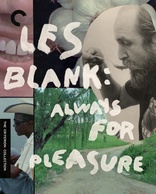
Price
Movie rating
7.1 | / 10 |
Blu-ray rating
| Users | 0.0 | |
| Reviewer | 4.5 | |
| Overall | 4.5 |
Overview
The Blues Accordin' to Lightnin' Hopkins (1968)
In his own words and "own own" music, Lightnin' Hopkins reveals the inspiration for his blues.
Director: Les Blank| Documentary | Uncertain |
| Short | Uncertain |
| Music | Uncertain |
Specifications
Video
Video codec: MPEG-4 AVC
Video resolution: 1080p
Aspect ratio: 1.33:1
Original aspect ratio: 1.33:1
Audio
English: LPCM Mono (48kHz, 24-bit)
Subtitles
None
Discs
50GB Blu-ray Disc
Single disc (1 BD)
Playback
Region A (locked)
Review
Rating summary
| Movie | 5.0 | |
| Video | 4.0 | |
| Audio | 4.0 | |
| Extras | 3.0 | |
| Overall | 4.5 |
The Blues Accordin' to Lightnin' Hopkins Blu-ray Movie Review
Reviewed by Jeffrey Kauffman July 7, 2019 Note: This film is available as part of Les
Blank: Always for Pleasure.
Chances are that unless you have a specialized interest in some of the indigenous folk music(s) of the United States, your recognition of the name
Les
Blank, if indeed you recognize it at all, may well come courtesy of
Burden of Dreams (note that the link points to a DVD, not a Blu-ray), Blank’s fascinating documentary about the filming of Werner
Herzog’s Fitzcarraldo. That piece was actually kind of an
outlier in Blank’s oeuvre, a large body of work that otherwise tended to focus primarily on musicians (though there are a couple of
exceptions in this set). Criterion’s collection of fourteen Blank
documentaries may understandably be thought of as a niche product, but for those interested in this subject, it’s a virtual smorgasbord of great
performances and at least some biographical data.
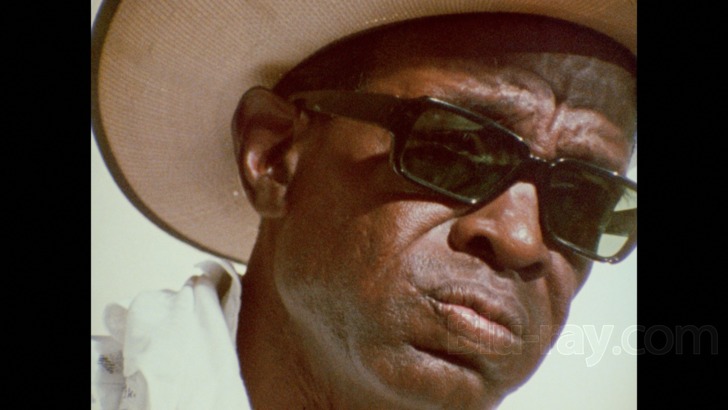
The Blues Accordin' to Lightnin' Hopkins was one of Blank's first projects after founding Flower Films, and it's a loving if often rather unvarnished look at one of the titans of blues. While ostensibly a biography (of sorts, anyway), this documentary is notable for how it captures the entire feeling of the far southern Texas community where Lightnin' lived and played. There are some amazing snippets of him doing just that in this piece, along with some frankly slightly odd collaborations. This is a film that manages to capture a man's spirit with surprisingly little talking, but one heck of a lot of fantastic music.
The Blues Accordin' to Lightnin' Hopkins Blu-ray Movie, Video Quality 

The Blues Accordin' to Lightnin' Hopkins is presented on Blu-ray courtesy of the Criterion Collection with an AVC encoded 1080p transfer in
1.33:1.
Criterion's insert booklet has the following information on the transfers in this set:
All fourteen films are presented in their original aspect ratio of 1.33:1. On widescreen televisions, black bars will appear on the left and right side of the image to maintain the proper screen format. These new digital transfers were created in 2K resolution on a Scanity film scanner from internegatives at Technicolor Los Angeles. Thousands of instances of dirt, debris, scratches, splices, warps, jitter, and flicker were manually removed using MTI's DRS and Pixel Farm's PFClean, while Digital Vision's Phoenix was used for small dirt, grain, and noise management.Aside from a few moments where clarity can falter (as in a dusky sequence on some train tracks, as evidenced by screenshot 4), this is a really nice looking transfer that preserves a kind of gritty but organic looking texture, while also supporting a natural and nicely vivid looking palette. There are a couple of moments of wonky looking contrast, especially when Blank chooses to back light his subjects, but on the whole detail levels are very precise looking. As with many of the offerings in this set, the Janus Films masthead has a bit of wobble, but there are no issues afflicting the actual documentary. Also as with several of the films in the set, there is an occasional stray hair stuck in the gate that can be spotted.
The Blues Accordin' to Lightnin' Hopkins Blu-ray Movie, Audio Quality 
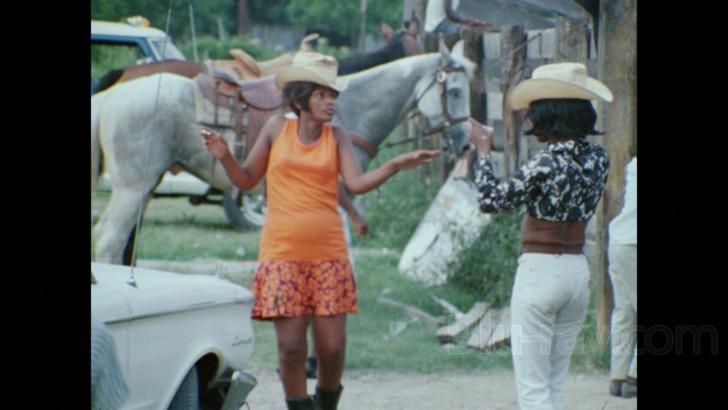
The Blues Accordin' to Lightnin' Hopkins features an LPCM Mono track.
Criterion's insert booklet has the following information on the soundtracks:
The original monaural soundtracks for The Blues Accordin' to Lightnin' Hopkins; A Well Spent Life; Dry Wood; Always for Pleasure; Garlic is as Good as Ten Mothers; Sprout Wings and Fly; In Heaven There is No Beer?; Gap-Toothed Women; Yum, Yum, Yum! A Taste of Creole and Cajun Cooking; and The Maestro: King of the Cowboy Artists were remastered at 24-bit from 35 mm full-coat magnetic tracks. The original monaural soundtrack for Hot Pepper was remastered at 24-bit from the original 16 mm full-coat magnetic track. The original monaural soundtrack for God Respects Us When We Work, but Loves Us When We Dance was remastered at 24-bit from a restored DA-98 tape and the restored 35 mm full-coat magnetic track. The original monaural soundtrack for Spend It All was remastered at 24-bit from a restored WAV file. And the original stereo soundtrack for Sworn to the Drum: A Tribute to Francisco Aguabella was remastered at 24-bit from the original 16 mm full-coat magnetic track. Clicks, thumps, hiss, hum, and crackle were manually removed using Pro Tools HD, AudioCube's integrated workstation, and iZotope RX3.With an understanding that everything here was recorded "live" on the fly, this is a nice, full bodied sounding track, albeit one that is understandably narrow. There are one or two moments of very minor distortion when amplitudes spike, and it almost sounds like they simply had the microphone too close to Lightnin' when he was playing. The mono aspect really doesn't afflict anything too seriously, however, given the fact that Lightnin' engages in several solos, and even the group numbers tend to be duets. Dialogue (including quite a bit of voiceover by Lightnin') is rendered cleanly, though as Taylor Hackford warns folks in a supplement, Lightnin's " patois" (as Hackford calls it) can be awfully hard to decipher, so the optional subtitles may come in handy for some.
The Blues Accordin' to Lightnin' Hopkins Blu-ray Movie, Special Features and Extras 
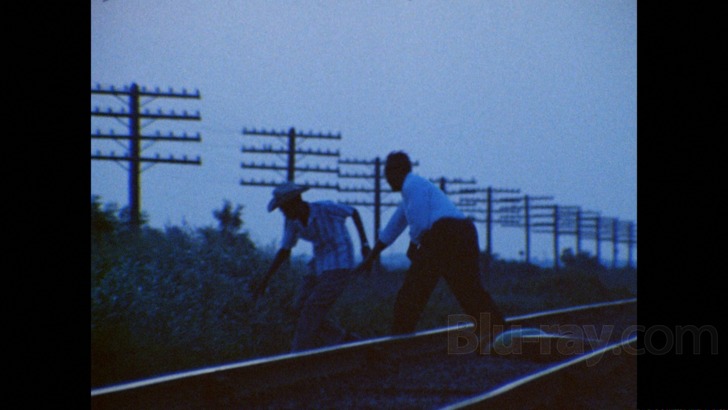
- The Sun's Gonna Shine (1080p; 9:55) is an engaging short done by Blank at the same time as the feature which "recreates" a memory of Lightnin' Hopkins', and which includes another great Hopkins performance.
- "Mr. Charlie, Your Rollin' Mill is Burnin' Down" (1080p; 7:30) features Hopkins performing the title song.
- "Lightnin' Les" (1080p; 3:32) features Hopkins performing this song, which was written to commemorate a card game he played with Blank.
- Making Lightnin' (1080p; 8:39) is a 2014 piece featuring Blank's frequent collaborator Skip Gerson.
- An Appreciation by Taylor Hackford (1080p; 10:04) stems from 2013 and offers the director's assessment of Blank's output.
The Blues Accordin' to Lightnin' Hopkins Blu-ray Movie, Overall Score and Recommendation 
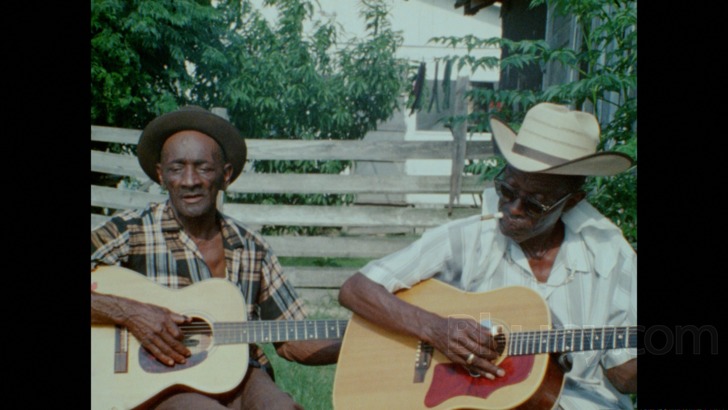
There's an interesting "credit" of sorts at the head of this film that says it includes "the people of Texas, 1967", and that may indicate what helps to make this such a satisfying piece. It's ostensibly about a legendary musician, but like so much else of Blank's work, it manages to offer a really touching depiction of an entire region and/or culture. Technical merits are solid, and The Blues Accordin' to Lightnin' Hopkins comes Highly recommended.
Similar titles
Similar titles you might also like
(Still not reliable for this title)

Spend It All
1971

Sprout Wings and Fly
1983

A Well Spent Life
1971

Dry Wood
1973

Sworn to the Drum: A Tribute to Francisco Aguabella
1995

God Respects Us When We Work, but Loves Us When We Dance
1968

In Heaven There Is No Beer?
1984

Hot Pepper
1973

Yum, Yum, Yum! A Taste of Cajun and Creole Cooking
1990

Gap-Toothed Women
1987

Always for Pleasure
1978

The Maestro: King of the Cowboy Artists
1994

Garlic Is as Good as Ten Mothers
1980

Anthem
1991

One More Time with Feeling
2016

A Poem Is a Naked Person
1974

The Velvet Underground
2021

Ryuichi Sakamoto: Opus
2023

Dig!
2004

Style Wars
1983